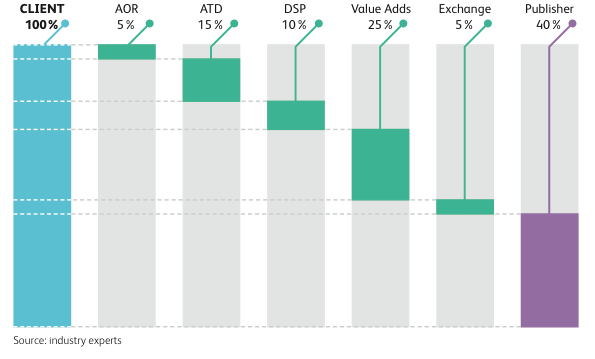The World Federation of Advertisers (WFA) has released a guide to Programmatic media, titled: What Every Advertiser Should Know about Media Markets.
The guide addresses the barriers faced by advertisers while explaining the advantages and solutions of programmatic buying.
Trading Desks
Advertisers can choose from three trading desks:
Agency Trading Desk: It makes all investment decisions and controls data and contracts, which at times could discourage brands on account of lack of transparency and control, besides yielding a relatively lower ROI. However, it’s the easiest way to get started.
Hybrid Trading Desk: An upgrade of sorts to the ATD, it allows advertisers more control in terms of visibility and exposure to contracts and even, promises better ROI. However, it is still resourced and located within the ATD and is not easy to switch.
Brand Trading Desk: It is probably the preferred choice of advertisers, as it allows advertisers to appoint the vendors themselves and provides an option to work with ATD thereby adding more flexibility. However, it requires far more planning, leadership and organization on the advertiser’s part than the previous two trading desks.
Leap of faith
Programmatic buying involves media impressions that can be bought and sold via electronic transactions in real-time and otherwise, states the guide. Advertisers would do far better if they treated media impressions with the same speculative psychology as they treat financial stocks or securities – with a certain idea of the return they can expect – instead of treating it like a utility purchase such as grocery shopping or an electricity contract. Lack of transparency and often conflict of interest discourages advertisers from programmatic media, but they can work around this by working with the right model.
Follow the trail

A model for how the money may be split between the various stakeholders, in the typical programmatic ‘stack’
Most ad networks do not provide a significant ROI or benefit for the advertiser, as a large part of the investment goes to the network. Though more than half of the advertiser’s investment goes to the middleman even in the ATB model; there is an opportunity for better control over the investment.
The guide states that both Agency Of Record (AOR) and ATD receive a share of advertiser spend. And as DSP software is typically licensed by ATDs, rather than owned, a share also goes to the companies providing these services. Eventually, the publisher or the ‘working media’ receives only 40 percent.
Since advertisers do not have control or access to information behind-the-scenes, 75 percent of advertisers view trading desks as less transparent than the traditional methods.
There is an opportunity for advertisers to build a culture wherein only certain, selected value-add partners are rewarded with commissions. Such kind of management of the suppliers will improve visibility and ROI for an advertiser.
What’s deterring advertisers?
Programmatic buying has its fair share of problems deterring advertisers from investing freely.
Transparency: Lack of clear information on pricing models, bidder strategies and inventory sources, which are inherent to the ATB model, are a major barrier for advertisers.
Invalid impressions: 20 percent or more of all display and mobile advertising impressions are invalid. This means that the ads are either not visible or the impressions, clicks or conversions are by automated or mechanical.
 Conflict of interest: The biggest conflict of interest for advertisers is known as ‘arbitrage’. It’s basically when the ATB buys impressions upfront and then sells those same impressions to the advertiser via programmatic buying channels. This is a cause for concern about the neutrality of the impressions as well as the prices they are being sold at.
Conflict of interest: The biggest conflict of interest for advertisers is known as ‘arbitrage’. It’s basically when the ATB buys impressions upfront and then sells those same impressions to the advertiser via programmatic buying channels. This is a cause for concern about the neutrality of the impressions as well as the prices they are being sold at.
The next step
Solutions exist to most of programmatic buying’s problems in the form of the Brand Trading desk, which provides more visibility and control to advertisers; and new accredited solutions for validating ad impressions. The ‘Viewable Impression’ has already been rolled out officially but is still limited. However, it has set the stone rolling for ‘Valid Impressions’, which would include ways of tracking bots and other automated and fraudulent activities.
Since an advertiser is dependent on the trading desk, it is very important to devise an investment strategy that will help advertisers outsmart, rather than outspend competition. The guide states that if the advertiser’s trading operation is better equipped than its competitors, it is in a strong position to win. It is the uniqueness of the advertiser’s approach in regards to targeting the right segments, using the right bidding algorithms and measuring the right things, that provides the edge.


 Back
Back 







